The following testimony was submitted for the record to the House Select Committee on Strategic Competition between the United States and the Chinese Communist Party on April 15, 2024, for the “The CCP’s Role in the Fentanyl Crisis” hearing.
Dear Chairman Gallagher, Ranking Member Krishnamoorthi, and distinguished members of the Select Committee on the CCP:
Thank you for holding this hearing entitled “The CCP’s Role in the Fentanyl Crisis.” The fentanyl epidemic in the United States remains a crucial multifaceted issue and a major public crisis that deserves close attention from the U.S. government. I am honored to have this opportunity to submit this statement for the record.
I am a senior fellow at the Brookings Institution where I direct the Initiative on Nonstate Armed Actors and the Brookings series the Fentanyl Epidemic in North America and the Global Reach of Synthetic Opioids. I also codirect the Africa Security Initiative. In addition to studying China’s role in various illegal economies over the past two decades, I have been directing a Brookings workstream on China’s role in illegal economies and Chinese criminal groups around the world. Illicit economies, such as the drug trade and wildlife trafficking, organized crime, corruption, and their impacts on U.S. security and regional dynamics are the domain of my work and the subject of several books I have written. I have conducted fieldwork on these issues in China, Asia, Latin America, and Africa.
The Brookings Institution is a U.S. nonprofit organization devoted to independent research and policy solutions. Its mission is to conduct high-quality, independent research and, based on that research, to provide innovative, practical recommendations for policymakers and the public. The statement for the record that I am submitting represents solely my personal views, and does not reflect the views of Brookings, its other scholars, employees, officers, and/or trustees.
This statement for the record draws closely on my Senate testimony submitted for the March 20, 2024, Senate hearing “Strengthening International Cooperation to Stop the Flow of Fentanyl into the United States” held by the Subcommittee on Emerging Threats and Spending Oversight Subcommittee of the Committee on Homeland Security and Governmental Affairs.
The overall picture
The synthetic opioid epidemic in North America is the most lethal drug epidemic in the world’s history. Since 1999, drug overdoses have killed over 1 million Americans.1 The death rate grew dramatically after 2012 when Chinese networks began supplying synthetic opioids, such as fentanyl, to the United States. In 2021, the number of fatalities was 106,699;2 in 2022, it is estimated to have been 107,477.3 Fentanyl, consumed on its own or mixed into fake prescription pills, heroin, and increasingly, methamphetamine and cocaine, accounted for most of the deaths.
The structural characteristics of fentanyl and other synthetic drugs, including the ease of developing similar, but not scheduled, analogs as well as new precursors—increasingly a wide array of dual-use chemicals—pose immense structural obstacles to controlling their supply.
U.S. domestic prevention, evidence-based treatment, harm reduction, and law enforcement measures are fundamental and indispensable to countering the devastating fentanyl crisis.
However, smartly-designed supply control measures can save lives. Thus, the United States must also focus on reducing supply and effectively engage China, the predominant source of fentanyl precursors, and Mexico, the predominant locus of fentanyl synthesis and trafficking to the United States, for that purpose.
However, counternarcotics cooperation with those two countries has been inadequate, as both China and Mexico eviscerated antidrug collaboration with the United States in recent years. Mexico eviscerated cooperation to a bare minimum because President Andrés Manuel López Obrador’s administration has been unwilling and uninterested in mounting any serious law enforcement policy toward Mexican criminal groups and has stayed away from substantially confronting them.
China altogether suspended antidrug cooperation in 2022 because it subordinates its international law enforcement assistance subordinates to its geostrategic relationships and leverages it for other purposes. In November 2023, the United States achieved a diplomatic breakthrough with China to restart cooperation. But the extent and durability of the cooperation is yet to be seen.
Until 2019, China was the principal source of finished fentanyl for the U.S. illegal market. In violation of U.S. laws, Chinese brokers, some criminal, some operating in the legal economy as well, shipped fentanyl to U.S. dealers, often through postal and other courier services. After years of intense diplomacy spanning the Obama and Trump administrations, China placed the entire fentanyl class of synthetic opioids on a regulatory schedule in May 2019.4 China also adopted stricter mail monitoring procedures.
Subsequently, Chinese networks switched to shipping precursor chemicals to Mexican criminal groups that then produce fentanyl in Mexico and smuggle it in various forms to the United States. Many precursor chemicals remain unscheduled, in part because they have widespread use in the legal manufacturing of chemical products and pharmaceutical goods.
China often maintains that it cannot act against the shipments of nonscheduled precursors from China. However, the Chinese networks that export precursors to Mexican cartels frequently do so with full knowledge that they are supplying the criminal market. Along with their precursors and pre-precursors, their shipments sometimes include instructions on how to most effectively convert the chemicals into fentanyl. In their directed Spanish advertisements that often bundle together uncontrolled fentanyl precursors, common cocaine adulterants, and unscheduled methamphetamine precursors, the Chinese sellers explicitly seek out Mexican buyers in the criminal market. Some of their ads even highlight their capacities to “clear customs in Mexico.”5 In other cases, Chinese brokers, disguising their identity, advertise online their connections to international drug traffickers, such as in India, to attract Mexican criminal groups.6
From 2020 onward, the Chinese government’s willingness to act against these Chinese criminal networks weakened substantially as China did not obtain from the United States the strategic payoffs it had expected for placing the entire class of fentanyl analogs on a regulatory schedule: a reduction in economic tariffs from the Trump administration and a reduction in strategic competition from the Biden administration. By the end of 2021, China was no longer interested in meaningfully cooperating with the United States in law enforcement and counternarcotics efforts. In August 2022, in retaliation for then-House Speaker Nancy Pelosi’s visit to Taiwan, China officially announced that it was ending all of its counternarcotics and law enforcement cooperation with the United States.7 For the following year and a half, China also purposefully failed to mount adequate internal enforcement against Chinese criminal networks exporting fentanyl and other synthetic drugs and their precursors and laundering money for the Mexican cartels.
The resurrection of U.S.-China counternarcotics cooperation
During the November 2023 summit between President Joe Biden and President Xi Jinping, Washington and Beijing announced the restart of counternarcotics cooperation in a significant diplomatic breakthrough.8 The announced renewed collaboration includes the re-creation of a joint U.S.-China counternarcotics working group.
In restarting cooperation, China principally sought to stabilize the bilateral relationship with the United States that had been caught up in tensions and crises unseen for decades. However, U.S. diplomacy and actions also played an important role in bringing China back to cooperation.
In the runup to the announcement, China’s National Narcotics Control Commission sent out notices to Chinese pharmaceutical companies across the country’s provinces that it was now monitoring and enforcing precursor export controls.9 This gesture was meant to signal the seriousness of its commitments to the United States, as was the fact that Xi himself publicly spoke about the resurrected antidrug cooperation. Like in 2019 and 2020, China also shut down some Chinese websites that were selling precursor chemicals to international criminal groups.
In return, Washington removed sanctions from the Institute of Forensic Science in China, which the United States had designated because of the institute’s complicity in human rights abuses in Xinjiang,10 a step long desired by China.
In January 2024, the recreated U.S.-China counternarcotics commission met for the first time. High-level Chinese officials promised ambitious outcomes, even as non-action hedging did not completely disappear from their public statements.11
According to U.S. officials, since then China began acting on U.S.-provided intelligence about Chinese drug networks.12
In Beijing, China also promised to expand its multilateral engagement on synthetic drug control. It has restarted reporting drug data to United Nations antidrug agencies.
Crucially, in Beijing, China agreed to collaborate in several law enforcement areas in which it had previously boycotted cooperation. Beijing promised to control pill press exports, a vital element of the illegal drug trade enabling the production of lethal, fake pills. For years, China had resisted such regulatory controls on pill presses to maximize its economic interests.
China also promised to cooperate with the United States in anti-money laundering (AML). For years, China was unwilling to cooperate with U.S. investigations into the role of Chinese networks laundering money for Chinese fentanyl exports and Mexican cartels. U.S. law enforcement agencies have had little visibility into China’s banking sector and China’s application of its AML controls. During the January 2024 counternarcotics bilateral conference, representatives from Chinese banks, including the Bank of China, attended side meetings.
Beyond disrupting financial flows to criminal actors, AML investigations generate powerful intelligence on criminal networks. Thus, strengthening AML efforts is always advantageous. With China, such collaboration is all the more useful because Chinese money launderers have become some of the world’s leading ones, expanding their operations in North America and Europe.13 They are now the go-to actors for Mexican cartels, and their money laundering is so efficient that they have been displacing the Black Peso Market.14
Chinese money laundering networks utilize a wide variety of money laundering tools and constantly innovate their methods. Since they can avoid the U.S., Mexican, and European formal banking systems and international wire transfers, they work around many core existing AML measures. And they solve one of the biggest challenges for the Mexican cartels: moving large amounts of bulk money from the United States and Europe to Mexico without law enforcement detection.
Chinese money laundering methods often interface with the formal banking systems only within a country—China, Mexico, or the United States, and sometimes only within China. As described in Drazen Jorgic’s Reuters special report,15 through a system of mirror transactions across several countries, Chinese money launderers deposit equivalent amounts of money across the money laundering chain. They interact with criminal actors, such as Mexican cartels, through encrypted platforms, burner phones, and codes. U.S. investigations and court cases reveal that the Bank of China has been among the Chinese financial firms utilized by Chinese operators to launder money for Mexican cartels.16
Laundering through casinos is analogous to these informal money transfers: Bulk cash is brought to a casino in Vancouver, for example, where the cartel-linked individual loses it while his money laundering associate in Macau wins and pays the Chinese precursor smuggling networks.17 In recent years, such as between 2021 and 2023, China clamped down on money laundering and gambling in Macau and encouraged countries in Southeast Asia and the Pacific, such as Australia, to cooperate with its effort to repatriate money to China.18
Other money laundering and value transfers between Mexican and Chinese criminal networks include trade-based laundering, a form of money laundering extremely challenging for law enforcement to counter. An example of trade-based laundering includes Chinese launderers for CJNG buying shoes in China and reselling them in Mexico to give the cartel the necessary cash.19
In the United States, Chinese money launderers have recently begun using counterfeit Chinese passports to open burner bank accounts. They swap cash for cashier’s checks, with which they purchase iPhones and other luxury goods sought in China. The resale of these goods in China generates further profits for the money laundering networks.20
Just like in Australia, a primary location of Chinese money laundering, Chinese money laundering networks in the United States are also moving into real estate, in addition to utilizing cryptocurrencies.21
Other pernicious forms of money laundering and value transfer utilize Mexican wildlife and plant products, such as marine and terrestrial animals and timber. Beyond facilitating crime, they pose massive threats to Mexican biodiversity and risk spreading catastrophic zoonotic epidemics and pandemics, including to the United States.
Mexican cartels are increasingly sourcing an expanding array of protected and unprotected species in Mexico coveted in China—for Traditional Chinese Medicine, aphrodisiacs, other forms of consumption, or as a tool of speculation—to pay for fentanyl and methamphetamine precursor chemicals. Such products include turtles, tortoises, crocodilians and other reptiles, jellyfish, abalone, sea cucumber, and other seafood, parrots, and jaguars as well as various hardwoods.22 The swim bladder of the endemic and protected Mexican totoaba fish, which is highly prized in Chinese markets, is a notorious example.23 Instead of paying in cash, Mexican cartels pay Chinese precursor brokers for these commodities.
The amount of value generated by such wildlife commodity payments, likely in the tens of millions of dollars, may not cover all of the precursor payment totals and is unlikely to displace other methods of money laundering and value transfer. But the potency-per-weight ratio of synthetic opioids makes their precursors very cheap—their total value likely also amounts to only tens of millions of dollars.24 Thus, precursor chemicals for fentanyl and other synthetic opioids are uniquely suited to be paid for by wildlife products, and this method of payment generates highly dangerous threats to public health and biodiversity.
Moving bulk cash across the U.S.-Mexico border is an increasingly dated method.25
What’s behind China’s renewed law enforcement cooperation?
Two factors brought about China’s collaboration turnaround:
- Chinese geostrategic calculations.
- Adroit and appropriately tough U.S. diplomacy.
In the last several years, U.S.-China relations deteriorated to a level of tensions unseen in decades across a wide range of issues—including military alliances and power projection in the Asia-Pacific, China’s facilitation of Russia’s egregious war against Ukraine, Chinese spying of sensitive technologies, and Taiwan.26 With China’s economic growth slowed since COVID-19, the intensified competition has put further strains on China.27 Both countries came to desire a more stable rivalry and looked for a way to put a floor underneath their relationship’s freefall. Resurrecting bilateral counternarcotics enforcement and military-to-military exchanges and increasing cooperation on climate change mitigation and artificial intelligence were all opportunities to do so.28
Moreover, U.S. diplomacy effectively raised the reputational and other costs for China and Chinese actors. In July 2023, the United States organized and launched a new Global Coalition to Address Synthetic Drug Threats.29 Although China prides itself on being a tough drug cop and tends to be very active in global counternarcotics diplomacy, it abstained from joining while nearly 100 countries signed up.30
China’s counternarcotics reputation took another hit in September 2023 when the United States placed Beijing on its annual list of major drug-producing or transit countries (aka the Majors List).31 While some countries have become indifferent to the listing, calculating they can escape sanctions through U.S. national security interest exceptions, these reputational costs do matter to China.
Crucially, in 2023, the U.S. Department of Justice issued a set of innovative and powerful indictments against Chinese networks selling nonscheduled precursors to Mexican cartels, and the Department of Treasury sanctioned various Chinese firms.32 The indictments centered on prohibitions of material support to organized crime groups and revealed Chinese suppliers are knowingly selling to Mexican cartels and providing them with formulas and kits on how best to process the nonscheduled chemicals into fentanyl.33 China has long excused its inaction against these flows by insisting it cannot act against nonscheduled chemicals, such as the dual-use precursors from which much of fentanyl is produced today.
As an important pressure tool, the United States denied visas to various Chinese officials and business executives, while the U.S. Congress held multiple hearings on China’s role in the U.S. drug epidemic and a U.S. Senate delegation to China emphasized the issue.34
What to watch for in U.S.-China collaboration
It is unlikely that China will end its approach of subordinating its antidrug and anti-crime cooperation to its strategic calculus. The United States has long hoped to get China to delink anti-crime cooperation from the overall state of the bilateral relationship and establish strong law enforcement cooperation separate from geopolitics.
In fact, China sees counternarcotics and more broadly international law enforcement cooperation as strategic tools that it can leverage to achieve other objectives. As Beijing’s hopes for improvements in U.S.-China relations declined in 2021, so too did China’s willingness to coordinate with Washington on counternarcotics objectives. Thus, even though China’s current goal is to reduce tensions, China’s drug cooperation is vulnerable to new crises in the bilateral relationship.
Moreover, Beijing rarely acts against the top echelons of large and powerful Chinese criminal syndicates unless they specifically contradict a narrow set of Chinese government interests. Chinese criminal groups cultivate political capital with Chinese authorities and government officials abroad by also promoting China’s political, strategic, and economic interests.
Key indicators of China’s seriousness about counternarcotics collaboration include:
- China’s responsiveness to U.S. intelligence provision.
- Reciprocal sharing of intelligence.
- Arrests and prosecutions in China.
- The extent and consistency of China’s monitoring and regulating of Chinese pharmaceutical and chemical industries.
- China’s willingness to adopt Know Your Customer (KYC) laws.
Yet China already warns that it is unlikely to deliver cooperation on several of these elements.
For example, China cautions that it will not be able to mount many arrests and prosecutions.
Furthermore, China still insists that it cannot prosecute nonscheduled substances, claiming the lack of material support laws pertaining to organized crime.35 If these laws are genuinely lacking in China, the world’s most extensive police and surveillance state, it should either strengthen the laws or find other mechanisms in its draconian drug laws, such as conspiracy and fraud charges, to prosecute Chinese violators.36
Beyond regular, not just one-off, messaging that China is now serious about controlling drug exports and the above-cited prosecutions, China’s willingness to promote the adoption of KYC laws and practices across these industries is an important measure and goal. Designed to protect institutions against fraud, participation in organized crime, corruption, money laundering, and terrorist financing by mandating that companies and individuals perform due diligence on their customers and do not engage in business with those that fall into the above categories, KYC laws are now commonplace around the world. Yet China has been reluctant to adopt such policies, calculating that such measures are too economically costly.37
Conversely, the United States should not judge the extent of China’s cooperation by the number of drug-induced deaths in the United States. Even if China were to robustly cooperate, deaths may not dip: In illicit drug markets, there are always lags of months or years between effective supply actions and retail changes. Besides, Mexican cartels have stockpiles of precursors, and they can source them from other sources, such as India or South Africa.38
Moreover, if drugs like xylazine (which is not responsive to the overdose medication naloxone) and other synthetic opioids like nitazenes start spreading beyond the East Coast (and escalate in Europe), overdose deaths will spike beyond the currently high levels.39
-
Footnotes
- Julie O’Donnell, Lauren J. Tanz, R. Matt Gladden, Nicole L. Davis, and Jessica Bitting, “Trends in and Characteristics of Drug Overdose Deaths Involving Illicitly Manufactured Fentanyls—United States, 2019-2020,” Morbidity and Mortality Weekly Report, 70, No. 50, December 17, 2021.
- Merianne Rose Spencer, Arialdi M. Miniño, and Margaret Warner, “Drug Overdose Deaths in the United States, 2001–2021,” NCHS Data Brief No, 457, Centers for Disease Control and Prevention National Center for Health Statistics, U.S. Department of Health and Human Services, December 2022, https://www.cdc.gov/nchs/data/databriefs/db457.pdf.
- “Dr. Rahul Gupta Releases Statement on CDC’s New Overdose Death Data,” The White House, Office of National Drug Control Policy, January 11, 2023, https://www.whitehouse.gov/ondcp/briefing-room/2023/01/11/dr-rahul-gupta-releases-statement-on-cdcs-new-overdose-death-data-2/#:~:text=Rahul%2520Gupta%252C%2520Director%2520of%2520the,period%2520ending%2520in%2520August%25202022.
- Mark Landler, “U.S. and China Call Truce in Trade War,” The New York Times, December 1, 2018, https://www.nytimes.com/2018/12/01/world/trump-xi-g20-merkel.html.
- Vanda Felbab-Brown’s interviews with two U.S. drug policy experts specializing in online sales of precursor agents, by virtual platforms, December 2021.
- Vanda Felbab-Brown’s interview with a foreign correspondent who has reported on China’s fentanyl and precursor markets, by virtual platform, November 2021.
- “The Ministry of Foreign Affairs Announces Countermeasures in Response to Nancy Pelosi’s Visit to Taiwan, Ministry of Foreign Affairs of the People’s Republic of China, August 5, 2022, https://www.fmprc.gov.cn/eng/zxxx_662805/202208/t20220805_10735706.html.
- Mike Wendling, “Five Things We Learned from the Biden-Xi Meeting,” BBC, November 16, 2023, https://www.bbc.com/news/world-us-canada-67433961.
- Martin Purbrick, “The Workshop of the World and the Tide of Fentanyl from China,” The Asian Crime Century, February 16, 2024, https://asiacrimecentury.substack.com/p/the-workshop-of-the-world-and-the.
- Nike Ching, “US Lifts Sanctions on Chinese Institute to Seek Fentanyl Cooperation,” Voice of America, November 16, 2023, https://www.voanews.com/a/us-lifts-sanctions-on-chinese-institute-to-seek-fentanyl-cooperation-/7358446.html; “Commerce Department to Add Nine Chinese Entities Related to Human Rights Abuses in the Xinjiang Uighur Autonomous Region to the Entity List,” U.S. Department of Commerce, May 22, 2020, https://www.commerce.gov/news/press-releases/2020/05/commerce-department-add-nine-chinese-entities-related-human-rights.
- Janis Mackey Frayer and Jennifer Jett, “U.S. and China to Hold High-Level Talks Aimed at Curbing the Fentanyl Crisis,” NBC News, January 26, 2024, https://www.nbcnews.com/news/world/us-china-fentanyl-talks-opioids-drugs-epidemic-precursor-rcna135399.
- Vanda Felbab-Brown’s interviews with U.S. officials, January-March 2024.
- Emilio Parodi, “Insight: Italian Drugs Cartels Conceal Payments via Chinese Shadow Banks | Reuters,” Reuters, April 6, 2023, https://www.reuters.com/world/europe/italian-drugs-cartels-conceal-payments-via-chinese-shadow-banks-2023-04-06/.
- Drazen Jorgic, “Special Report: Burner Phones and Banking Apps – Meet the Chinese ‘brokers’ Laundering Mexican Drug Money,” Reuters, December 3, 2020, https://www.reuters.com/article/us-mexico-china-cartels-specialreport/special-report-burner-phones-and-banking-apps-meet-the-chinese-brokers-laundering-mexican-drug-money-idUSKBN28D1M4/.
- Ibid.
- Ibid.
- For further details, see various hearings of the Commission of Inquiry into Money Laundering in British Columbia, https://www.cullencommission.ca; Sam Cooper, “Exclusive: How B.C. casinos are used to launder millions in drug cash,” Vancouver Sun, September 29, 2017, https://vancouversun.com/news/national/exclusive-how-b-c-casinos-are-used-to-launder-millions-in-drug-cash.
- Joanna Ossinger and David Ingles, “These Charts Show Impact of China’s Casino Crackdown on Macau,” Bloomberg, September 15, 2021, https://www.bloomberg.com/news/articles/2021-09-16/these-charts-show-impact-of-china-s-casino-crackdown-on-macau.
- Drazen Jorgic, “Special report: Burner phones and banking apps.”
- Homeland Security Investigations, Cornerstone Issue No. 48, January 2024, https://content.govdelivery.com/accounts/USDHSICE/bulletins/37fff16.
- Vanda Felbab-Brown’s interviews with U.S. law enforcement officials, spring 2024.
- Vanda Felbab-Brown, “China’s Role in Poaching and Wildlife Trafficking in Mexico” (Washington, DC: The Brookings Institution, March 2022, https://www.brookings.edu/events/chinas-role-in-poaching-and-wildlife-trafficking-in-mexico/.
- For background, see Vanda Felbab-Brown and Alejandro Castillo, “Restore US-Mexico seafood trade & save the vaquita,” Mexico Today, May 7, 2021, https://mexicotoday.com/2021/05/07/opinion-restore-us-mexico-seafood-trade-save-the-vaquita/; and Enrique Sanjurjo-Rivera et al., “An Economic Perspective on Policies to Save the Vaquita: Conservation Actions, Wildlife Trafficking, and the Structure of Incentives,” Frontiers in Marine Science (August 27, 2021), https://doi.org/10.3389/fmars.2021.644022.
- Vanda Felbab-Brown’s interviews with U.S. law enforcement officials, Mexico City and by virtual platforms, October 2021.
- Vanda Felbab-Brown’s interviews with U.S. law enforcement officials, spring 2024.
- Ryan Hass, “What America Wants From China,” Foreign Affairs, October 24, 2023, https://www.foreignaffairs.com/united-states/what-america-wants-china-hass; Dan De Luce, “China Helps Russia Evade Sanctions, Likely Supplies Moscow with War Tech Used in Ukraine,” NBC News, July 27, 2023, https://www.nbcnews.com/news/investigations/china-helps-russia-evade-sanctions-tech-used-ukraine-war-rcna96693; Courtney Kube and Carol E. Lee, “Chinese Balloon Got Intel from U.S. Military Sites, despite Efforts to Block It,” NBC News, April 3, 2023, https://www.nbcnews.com/politics/national-security/china-spy-balloon-collected-intelligence-us-military-bases-rcna77155.
- Laura He, “Analysis: China’s Economy Had a Miserable Year. 2024 Might Be Even Worse,” CNN, December 28, 2023, https://www.cnn.com/2023/12/27/economy/china-economy-challenges-2024-intl-hnk/index.html.
- “Readout of President Joe Biden’s Meeting with President Xi Jinping of the People’s Republic of China,” The White House, November 16, 2023, https://www.whitehouse.gov/briefing-room/statements-releases/2023/11/15/readout-of-president-joe-bidens-meeting-with-president-xi-jinping-of-the-peoples-republic-of-china-2/.
- “Global Coalition to Address Synthetic Drug Threats,” United States Department of State, July 2023, https://www.state.gov/globalcoalition/.
- “Highlighting U.S. and Global Efforts to Address the Health and Security Threats of Synthetic Drugs Through Global Cooperation,” United States Department of State, September 26, 2023, https://www.state.gov/highlighting-u-s-and-global-efforts-to-address-the-health-and-security-threats-of-synthetic-drugs-through-global-cooperation/.
- “Memorandum on Presidential Determination on Major Drug Transit or Major Illicit Drug Producing Countries for Fiscal Year 2024,” The White House, September 15, 2023, https://www.whitehouse.gov/briefing-room/presidential-actions/2023/09/15/memorandum-on-presidential-determination-on-major-drug-transit-or-major-illicit-drug-producing-countries-for-fiscal-year-2024/.
- “Justice Department Announces Eight Indictments Against China-Based Chemical Manufacturing Companies and Employees,” United States Department of Justice, October 3, 2023, https://www.justice.gov/opa/pr/justice-department-announces-eight-indictments-against-china-based-chemical-manufacturing; “Treasury Targets Large Chinese Network of Illicit Drug Producers,” U.S. Department of the Treasury, March 13, 2024, https://home.treasury.gov/news/press-releases/jy1779.
- “Justice Department Announces Charges Against China-Based Chemical Manufacturing Companies and Arrests of Executives in Fentanyl Manufacturing,” United States Department of Justice, June 23, 2023, https://www.justice.gov/opa/pr/justice-department-announces-charges-against-china-based-chemical-manufacturing-companies.
- “Senator Hassan Statement on U.S.-China Fentanyl Agreement,” Office of Sen. Maggie Hassan, November 16, 2023, https://www.hassan.senate.gov/news/press-releases/senator-hassan-statement-on-us-china-fentanyl-agreement.
- Vanda Felbab-Brown’s interviews with U.S. government officials, fall and winter 2023 and spring 2024.
- See Paul Mozur, Muyi Xiao, and John Liu, “‘An Invisible Cage’: How China Is Policing the Future,” The New York Times, June 26, 2022, https://www.nytimes.com/2022/06/25/technology/china-surveillance-police.html; and “Drug Laws Around the World: Death Penalty for Drugs,” Drug Abuse, December 17, 2013, https://drugabuse.com/blog/the-20-countries-with-the-harshest-drug-laws-in-the-world/.
- Vanda Felbab-Brown’s interviews with U.S. government officials, fall and winter 2023 and spring 2024, and with Chinese drug policy experts, spring 2024.
- Vanda Felbab-Brown, “China and Synthetic Drugs Control: Fentanyl, Methamphetamines, and Precursors” (Washington, D.C: The Brookings Institution, March 2022), https://www.brookings.edu/wp-content/uploads/2022/03/FP_20221107_drug_trafficking_felbab_brown.pdf.
- See Anisha Kohli, “Inside the Emerging Xylazine Addiction Crisis in the U.S.,” TIME, May 18, 2023, https://time.com/6280860/xylazine-fentanyl-philadelphia-addiction-crisis/; Adam Holland et al., “Nitazenes—Heralding a Second Wave for the UK Drug-Related Death Crisis?,” The Lancet Public Health 9, no. 2 (February 2024): e71–72, https://doi.org/10.1016/S2468-2667(24)00001-X; and Alison Athey, Beau Kilmer, and Julie Cerel, “An Overlooked Emergency: More Than One in Eight US Adults Have Had Their Lives Disrupted by Drug Overdose Deaths,” American Journal of Public Health 114, no. 3 (March 2024): 276–79, https://doi.org/10.2105/AJPH.2023.307550.
The Brookings Institution is committed to quality, independence, and impact.
We are supported by a diverse array of funders. In line with our values and policies, each Brookings publication represents the sole views of its author(s).

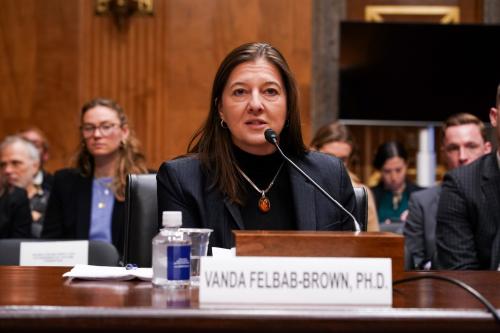
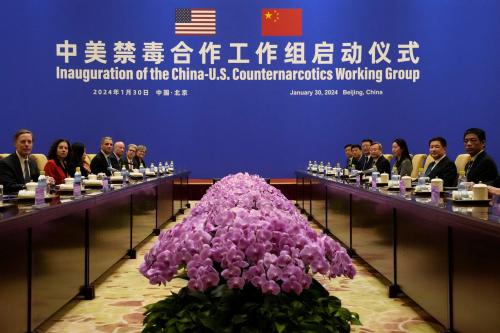
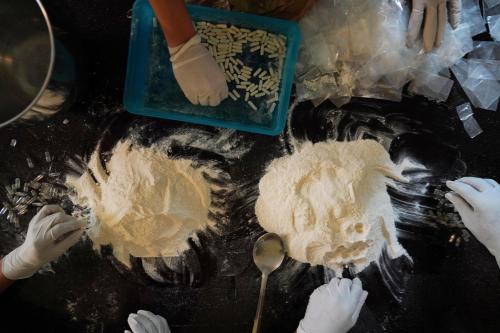
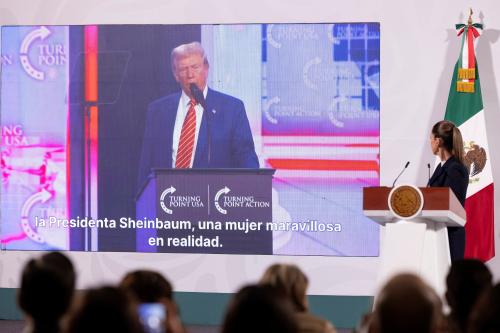

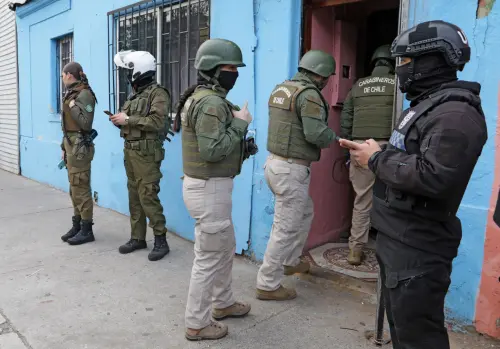
Commentary
TestimonyThe limits of renewed US-China counternarcotics cooperation
April 16, 2024